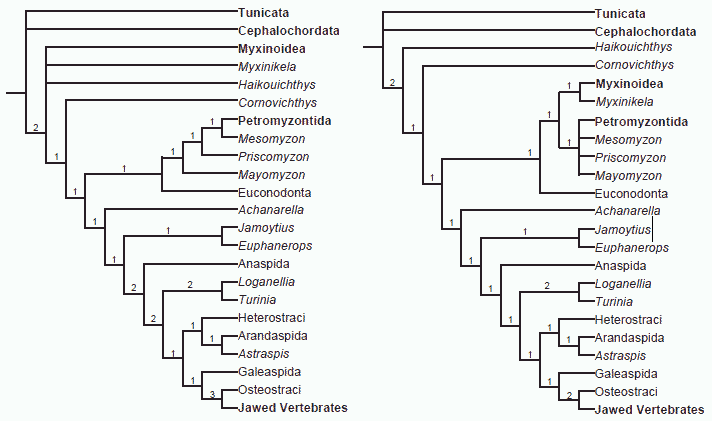Jamoytiiformes
Taxa on This Page
- Euphanerops X
- Jamoytiiformes X
- Jamoytius X
The first fish
Among the ostracoderms, to give the term for a paraphyletic evolutionary grade of jawless fish found in books by Romer, Colbert, etc (Evolutionary Systematics), the Anaspida was an assemblage of unarmoured forms that, like the thelodonts, seem to have become something of a wastebasket taxon for early agnaths that did not belong elsewhere. Leading vertebrate phylogenist Philippe Janvier was the first to make a systematic study of the group on cladistic grounds (Janvier 1996). He argued that the Anaspida are ancestral or basal lampreys, via intermediate forms like Endeiolepis. More recently he has modified this original position by distinguishing between more primitive forms like Euphanerops, and the Anaspida proper Janvier, 2007b. The former might be on the lamprey stem, whereas the latter are more derived forms. He has also synonymised Endeiolepis, Legendrelepis, and Euphanerops e.g. Janvier 2008, p.1051
An alternative hypothesis is proposed by Sansom and co-workers (Sansom et al 2010) who re-examined the well-known early Silurian anaspid Jamoytius kerwoodi, taking into account taphonomic studies, topological analysis, model reconstruction and elemental analysis, to arrive at a more accurate anatomical interpretation, and on this basis provided a new cladistic analysis they discovered that Jamoytius and Euphanerops (= Endeiolepis) form a clade, which they named Jamoytiiformes, which are stem-gnathostomes rather than proto-lampreys or Anaspida. Their cladogram also revealed the Anaspida to be similarily along the line to gnathostomes, and not related to Petromyzoniformes. So far this agrees with Janvier. Where it differs is that the Jamoytiiformes, including Euphanerops are now removed from the Hyperoartia. Apart from leaving the lampreys without obvious ancestors (except possibly conodonts), this means, taxonomically, than the Hyperoartia becomes a synonym of Petromyzoniformes, or vice versa, depending on your choice of terminology. The cladogram is as follows:
 |
Left: single most parsimonious tree from the unconstrained phylogenetic analysis with decay support indices. |
Right: Strict consensus of trees resulting from analysis constrained for cyclostome monophyly (according to molecular phylogeny) with decay indices. |
Phylogenetic relationships of Jamoytius and related taxa. |
Here, the very basal position of the otherwise typically Anaspid- or Jamoytius-like form Cornovichthys as a stem-vertebrate is supported only by a single equivocal character (anterior otic capsules), and hence may not be reliable. The authors suggets that the stem placements of Cornovichthys and Achanarella are more likely to reflect taphonomic bias resulting from loss of characters through post-mortem decay (Donoghue and Purnell 2009; Sansom et al. 2010). The placement of conodonts as stem-lampreys differs from previous analyses, although it is the most parsimonious on the basis of the morphological data. The addition of other soft-bodied taxa in phylogenetic analaysis will therefore affect hypotheses of euconodont relationships, although trhe premise that euconodonts are vertebrates seems solid (Sansom et al 2010).
All of which pretty much demolishes the Linnaean/Evolutionary Systematic classification of the Anapsida given by Tarlo 1967. This does not mean that any Linnaean style arrangement has to be discarded in every instance, but simply because no one in vertebrate palaeontology is now working in this area, so any coverage is naturally out of data. Elsewhere we will presenting informal Linanean classifications of various taxa, with the proviso that these are not taken too seriously!
Changing the coding strategy for dentine and odontodes results in the thelodonts (represented in the cladograms by Loganellia and Turinia) being more basal than the pteraspidimorphi. We await further results on this matter before revising all our trees of early vertebrates! MAK111027
Jamoytiiformes Tarlo, 1967
Comments: Jamoytiiformes appear cladistically as stem-gnathostomes because of their trunk dermal skeleton, separate anal fin and paired fin folds. They are however are more primitive than Anaspida because of the absence of dermal head skeleton, dentine and lamellar aspidin. Sansom et al 2010 MAK111022
 |
|
New reconstruction of Jamoytius kerwoodi
|
Jamoytius: J. kerwoodi
Early Silurian of Scotland.
Characters: W-shaped phosphatic scales, 10 or more pairs of branchial openings, optic capsules, a circular, subterminal mouth and a single terminal nasal opening. (Sansom et al 2010)
Comments: Jamoytius is commonly considered to represent either a primitive anaspid or ancestral lamprey. Analysis by Sansom et al 2010 establishes sister taxon relationship with Euphanerops.. Sansom et al 2010. The generic name honours Paleozoic fish specialist J. A. Moy-Thomas (ref Dawkins, The Ancestor's Tale, via Wikipedia). MAK111022
Euphanerops: E. longaevus
Synonyms Endeiolepis aneri, Legendrelepis parenti
Characters: tail strongly heterocercal; no mineralized exoskeleton ATW040314
Comment: Probably cogeneric with Euphanerops MAK111022
Links: Vertebrata; Anaspida; DEVONIANO vegetais primitivos Portuguese); Page 1. ATW040314.
MAK111027


